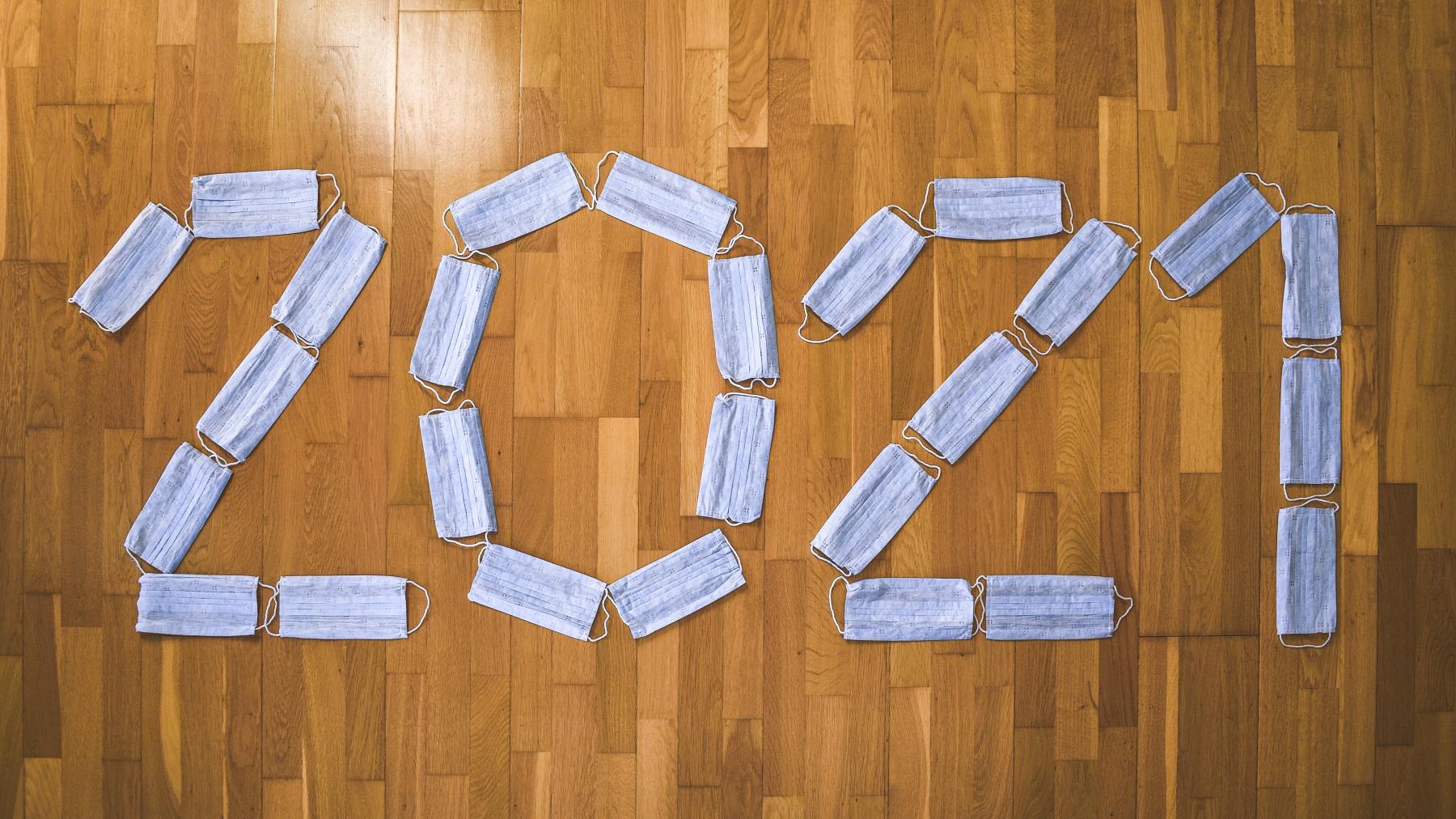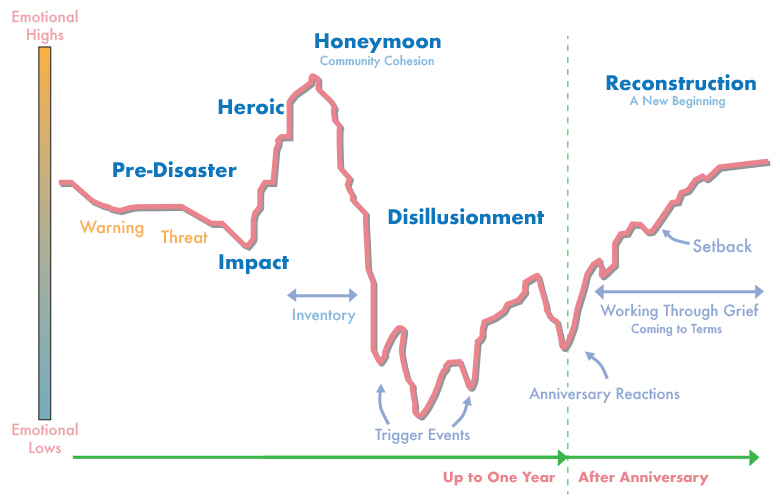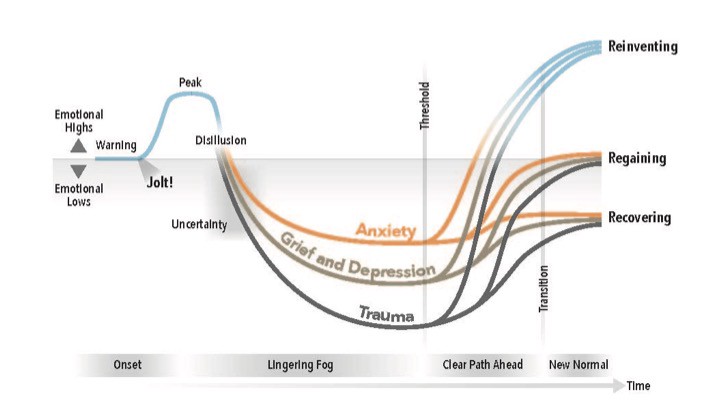Welcome to 2021. In what feels like a never-ending marathon, we’re approaching the one-year mark of the start of the COVID-19 pandemic in the U.S.
For many, the start of a new year is typically a sign of hope and a fresh start. Unfortunately, COVID-19 hasn’t disappeared with the turn of the calendar. But the first doses of the COVID-19 vaccines, distributed to over 138,000 Coloradans so far, provide a huge push toward the finish line. In order to keep this momentum going, it’s important to consider where we’ve been, plan for where we want to go, and know that not everyone will emerge from this pandemic the same.
The Substance Abuse and Mental Health Services Administration (SAMHSA) provides a model that reflects the emotional highs and lows we have experienced so far and charts a course for where we may be headed.
The Emotional Phases of Disaster and COVID-19
SAMHSA’s model was intended for use by mental health and human service workers during major disasters, but many will have experienced the same emotional phases during the pandemic. Community and individual reactions progress through six phases, which are characterized by both psychological and external events.
Source: Substance Abuse and Mental Health Services Administration
Where Have We Been and Where Are We Now?
First is the pre-disaster phase – a time of fear and uncertainty. For many, this came when we first learned about the coronavirus, or when the first case appeared in Washington state. Next is the impact phase – a realization that the disaster has arrived, like the declaration of a national public health emergency and statewide stay-at-home orders. Depending on the disaster, reactions during this phase vary. In the case of this pandemic, we ran the gamut from panic and confusion – stockpiling toilet paper, cleaning supplies, and food, as well as interpreting mixed messages from our nation’s leaders – to anger and disbelief. From here, the heroic and honeymoon phases emerged – a short-lived peak of emotional highs, altruism, and community bonding. We pushed for a sense of togetherness while we were physically apart. Coloradans howled nightly at 8 p.m. in solidarity and to show their support for health care workers. And when hospitals were short on personal protective equipment (PPE), we held supply drives and learned to sew masks.
But then came disillusionment. We experienced emotional lows and became fatigued as the pandemic continued. We also experienced a reality of the losses incurred. Loss of loved ones. Loss of daily routines. Loss of jobs or financial stability. Loss of some of our favorite locally owned businesses. And still, a continued need for physical distancing, and no clear end in sight.
In the disillusionment phase, we take separate paths. Art Kleiner, a business writer and editor, and Cheri Lovre, the founder of the Crisis Management Institute in Oregon, write that some have experienced ongoing anxiety, others grief, depression, or trauma.
Source: Cheri Lovre and Art Kleiner: Finding Our Way Through the Rest of the Pandemic
As we near the one-year mark and pass milestone events like the development of the COVID-19 vaccine, we have approached, and perhaps even crossed, the threshold depicted in Kleiner and Lovre’s graph and moved into the clear path ahead toward a new normal. We can finally see the path ahead and the potential to begin the last phase: reconstruction and a new beginning.
What We Can Learn From These Models
The pandemic has taught us many lessons, but here are three illuminated by these models that we can keep in mind as we begin this new year:
- Disillusionment is a rollercoaster, but policy choices can’t be driven by our emotional state. As illustrated by SAMHSA’s model, the disillusionment phase can be extended by trigger events. In summer 2020 we had a false sense of optimism and let our guard down. Policy choices that were made ultimately led to another emotional low as cases increased and restrictions re-tightened, and Coloradans were asked to spend our holidays differently. Moving forward, even with the vaccine in our arsenal, state leaders need to be thoughtful and account for how we can end this pandemic long-term. Decisions made with nearsightedness will create a false sense of security and could lead to another trigger event, reverting us back into disillusionment and extending our time in this challenging phase.
- There is hope ahead, but we’re not out of the woods yet. SAMHSA’s model appears bumpy for a reason. Our emotional responses will go up and down throughout all six phases. We may even experience a setback while in reconstruction. But we, as individuals, can all do our part to make sure we move forward as a community, and as a nation, to a true reconstruction phase by continuing to wear face coverings and physically distancing. And importantly, we can do our best to keep our spirits high knowing that the road ahead will be long, but the pandemic won’t last forever.
- Reconstruction will be different for all of us, but we can all work toward a new better. Kleiner and Lovre’s model shows that in addition to experiencing different disillusionment phases, we will also come out of the pandemic differently. Most people will be regaining their normalcy: The pandemic will become a memory and life will move on. Some will be left recovering; those who experienced losses may have ongoing emotional lows, and the pandemic and its lingering effects may cause continued struggle, financial or otherwise. Their model also shows that some will be reinventing and will come out of the pandemic stronger than before. Arguably, each of us can be a part of this reinvention. We can begin to think and talk about the future differently to collectively work toward a new better. Instead of being complacent and going back to what we thought was normal, we have the opportunity to rebuild our society to become more equitable.
So, with the arrival of a new year and a new vaccine comes a new hope. This time, as we rally together, we can keep in mind these emotional response phases, and keep making choices that can propel us through reconstruction toward recovering, regaining, and reinventing.
Related Blogs and Research




